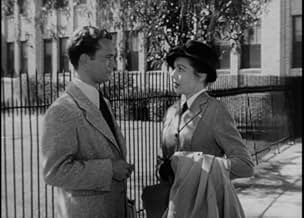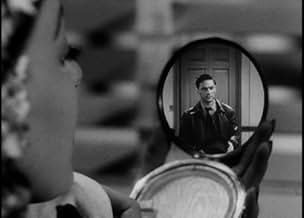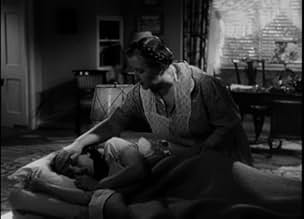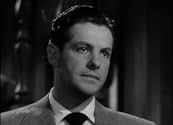AVALIAÇÃO DA IMDb
6,8/10
1,2 mil
SUA AVALIAÇÃO
Adicionar um enredo no seu idiomaA beautiful psychology professor tries to hide a self-defense killing.A beautiful psychology professor tries to hide a self-defense killing.A beautiful psychology professor tries to hide a self-defense killing.
- Direção
- Roteiristas
- Artistas
- Prêmios
- 1 vitória no total
Billy Mauch
- Harry Brice
- (as Bill Mauch)
Eric Alden
- Detective
- (não creditado)
John Bishop
- Detective
- (não creditado)
Gladys Blake
- Boxing Fan
- (não creditado)
Barbara Brewster
- Miss Comar - Abe's Mother
- (não creditado)
Douglas Carter
- Detective
- (não creditado)
Avaliações em destaque
This is actually a love story and, as is usually the case with noirs of the 40s, a very well written one, especially since it deals with some rather tricky psychological matters, of which guilt complex resulting in fear approaching the borders of possible schizophrenia is just one. What makes this film more than average of classy noirs of the 40s with a romantic and seriously psychological intrigue is the interesting peripatetic moment of the boxing match, when Loretta Young unintentionally gives herself away, and how very interestingly Robert Cummings as her lawyer and lover reacts to that. The acting is superb throughout, the story is credible and convincing, the dilemma of unintentionally having killed someone and the natural urge to avoid the consequences and take responsibility for what was not intended, anyone can understand and relate to. To all this comes Victor Young's endearing score fashioning the experience with a golden frame, the beauty of which increases all the time. In brief, this is a much underrated, unjustly forgotten and deeply human and interesting film, that deserves some intention after having been more or less buried alive since 50 years.
The twist on what we now call sexual harassment lingers as the most interesting aspect of The Accused, an innocuous suspense story with some effective moments. Another lingering aftertaste is the midcentury stereotype of the female academic that's foisted on star Loretta Young -- and the viewer.
Psychology professor Young (!), guarded and old-maidish (she's even saddled with the glamourproof name Wilma Tuttle), becomes the object of the unhealthy attentions of one of her students (Douglas Dick). On the pretext of diving for abalone shells off Malibu, he spirits her off to a secluded lover's lane one night and forces himself on her. She bashes in his skull and fakes his death to look accidental.
Then she begins to attract more attention -- from Robert Cummings, a lawyer friend of the dead boy's family (he falls for her), and Wendell Corey, a dogged homicide cop. In the acting department, there's no contest; Cummings stays his usual namby-pamby self, while Corey delivers a strong, unsentimental performance, among his best.
Much of William Dieterle's direction shows a practiced hand. Especially well handled are the opening sequence of Young fleeing the crime scene, a boxing match where she suffers a flashback, and the ghoulish reconstructions of the murder by forensic pathologist Sam Jaffe.
But a glaring structural flaw keeps The Accused lukewarm. We know from the outset that Young acted in self-defense, which pretty well leeches all the suspense out of Corey's implacable pursuit; the tightening case against her packs no impact because it's safe to assume she won't be spending any time with those harpies from Caged. Consequently the film focuses more on her emergence from a cocoon of droopy skirts, a bun in her hair, sleeping pills and swooning spells into a seductive butterfly flitting into Cummings' net.
Dick, as the young narcissist, calls to mind such amoral charmers as Robert Walker in Strangers On A Train and John Dall in Rope (a film in which Dick also appeared). It's he -- not young nor Cummings -- who supplies what faint erotic spark this movie, about a sexually-based murder, dares to kindle.
Psychology professor Young (!), guarded and old-maidish (she's even saddled with the glamourproof name Wilma Tuttle), becomes the object of the unhealthy attentions of one of her students (Douglas Dick). On the pretext of diving for abalone shells off Malibu, he spirits her off to a secluded lover's lane one night and forces himself on her. She bashes in his skull and fakes his death to look accidental.
Then she begins to attract more attention -- from Robert Cummings, a lawyer friend of the dead boy's family (he falls for her), and Wendell Corey, a dogged homicide cop. In the acting department, there's no contest; Cummings stays his usual namby-pamby self, while Corey delivers a strong, unsentimental performance, among his best.
Much of William Dieterle's direction shows a practiced hand. Especially well handled are the opening sequence of Young fleeing the crime scene, a boxing match where she suffers a flashback, and the ghoulish reconstructions of the murder by forensic pathologist Sam Jaffe.
But a glaring structural flaw keeps The Accused lukewarm. We know from the outset that Young acted in self-defense, which pretty well leeches all the suspense out of Corey's implacable pursuit; the tightening case against her packs no impact because it's safe to assume she won't be spending any time with those harpies from Caged. Consequently the film focuses more on her emergence from a cocoon of droopy skirts, a bun in her hair, sleeping pills and swooning spells into a seductive butterfly flitting into Cummings' net.
Dick, as the young narcissist, calls to mind such amoral charmers as Robert Walker in Strangers On A Train and John Dall in Rope (a film in which Dick also appeared). It's he -- not young nor Cummings -- who supplies what faint erotic spark this movie, about a sexually-based murder, dares to kindle.
A college professor (Young) commits murder while defending against an over-amorous student.
That noirish opening scene of a dark figure struggling along a deserted nighttime highway is iconic, especially when followed in flashback by deserted city streets and a lonely all-night bus. But once the flashbacks end, the movie settles into a fairly routine game of cat- and-mouse with strong psychological overtones. I'm also tempted to say the movie becomes a vehicle for Young, who gets to transform from dowdy career woman to fashionable beauty. However, the male roles (Cummings & Corey) are too large and well acted to allow that. Nonetheless, the film remains a Young showcase where the diva even gets to do the little fashion pirouette that distinguished her TV series.
Note a convention of the time: namely, that a woman can't have a career and be beautiful at the same time. Thus, Wilma (catch the plain-Jane name) as a professor is both grim and repressed. It's only after she essentially drops the career role that her appearance flowers. Young handles the demanding transition pretty well, without going over the top. Nonetheless, the number of close-ups leaves no doubt who the star is. My money, however, is on the rather exotic Wendell Corey (Det. Grogan). He's such an icy presence, it's hard to keep your eyes off him. Too bad that alcohol got the best of this unusual actor.
All in all, the pace may drag at times, but the movie still features enough points of interest to keep the momentum going.
That noirish opening scene of a dark figure struggling along a deserted nighttime highway is iconic, especially when followed in flashback by deserted city streets and a lonely all-night bus. But once the flashbacks end, the movie settles into a fairly routine game of cat- and-mouse with strong psychological overtones. I'm also tempted to say the movie becomes a vehicle for Young, who gets to transform from dowdy career woman to fashionable beauty. However, the male roles (Cummings & Corey) are too large and well acted to allow that. Nonetheless, the film remains a Young showcase where the diva even gets to do the little fashion pirouette that distinguished her TV series.
Note a convention of the time: namely, that a woman can't have a career and be beautiful at the same time. Thus, Wilma (catch the plain-Jane name) as a professor is both grim and repressed. It's only after she essentially drops the career role that her appearance flowers. Young handles the demanding transition pretty well, without going over the top. Nonetheless, the number of close-ups leaves no doubt who the star is. My money, however, is on the rather exotic Wendell Corey (Det. Grogan). He's such an icy presence, it's hard to keep your eyes off him. Too bad that alcohol got the best of this unusual actor.
All in all, the pace may drag at times, but the movie still features enough points of interest to keep the momentum going.
Good film noir concerning a prudish, but attractive, college prof that kills a student, during what today would be considered 'date rape.' Cummings and Corey are capable co-stars, and the lovely Young as always, is easy on the eyes.
Here is as "quiet" a suspense film as you are likely to encounter. That is all to the good, as beneath its placid surface crackle psychological crosscurrents that generate tension throughout. Each of the main characters is an interesting study, with ambivalent emotions that alternately spark and grate against those of the others. Additionally (and ironically), these characters are all involved in recognizing and dealing with such behavior, being a psychology professor, a detective and a lawyer respectively. A bit verbose at times, and resolved with a glib, less-than-satisfying ending, this picture nevertheless deserves a wider audience - if it has any at all nowadays. The performances are rock-solid and properly understated for the most part (even by Robert Cummings) in keeping with the conservative small town atmosphere; but there are effective contrasting performances as well, in the smaller roles of the few relatively unbalanced characters, as played by Douglas Dick, Suzanne Dalbert, and especially Sam Jaffee.
Você sabia?
- CuriosidadesOne of over 700 Paramount productions, filmed between 1929 and 1949, which were sold to MCA/Universal in 1958 for television distribution, and have been owned and controlled by Universal ever since. Its earliest documented telecast took place in Seattle Friday 24 October 1958 on KIRO (Channel 7); it first aired in Phoenix Friday 13 March 1959 on KVAR (Channel 12), and it soon became a popular local film favorite as it was first aired in Denver 9 April 1959 on KBTV (Channel 9), by both Chicago and Milwaukee 25 April 1959 on WBBM (Channel 2) and WITI (Channel 6), by Boston 10 May 1959 on WBZ (Channel 4), by Asheville 17 May 1959 on WLOS (Channel 13), by Grand Rapids 5 September 1959 on WOOD (Channel 8), by Detroit 22 September 1959 on WJBK (Channel 2), by Philadelphia 26 September 1959 on WCAU (Channel 10), by Los Angeles 3 October 1959 on KNXT (Channel 2), by Johnstown 30 October 1959 on WJAC (Channel 6), by Minneapolis 4 November 1959 on WTCN (Channel 11), by Toledo 20 November 1959 on WTOL (Channel 11), by Omaha 21 November 1959 on KETV (Channel 7), and by Pittsburgh 16 January 1960 on KDKA (Channel 2). It was released on DVD 28 September 2016 as part of the Universal Vault Series.
- Erros de gravaçãoWarren Ford invites Dr. Tuttle for breakfast, even though it is twelve noon, when lunch would be more appropriate.
- Citações
[Wilma is dressed for a date.]
Warren Ford: It's remarkable! Your brains don't show a bit.
- ConexõesFeatured in Frances Farmer Presents: The Accused (1960)
Principais escolhas
Faça login para avaliar e ver a lista de recomendações personalizadas
- How long is The Accused?Fornecido pela Alexa
Detalhes
- Tempo de duração
- 1 h 41 min(101 min)
- Cor
- Proporção
- 1.37 : 1
Contribua para esta página
Sugerir uma alteração ou adicionar conteúdo ausente


































